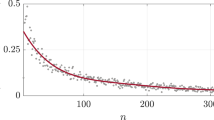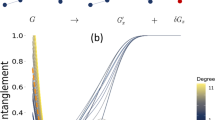Abstract
A large number of complex networks are scale-free1,2 — that is, they follow a power-law degree distribution. Here we propose that the emergence of many scale-free networks is tied to the efficiency of transport and flow processing across these structures. In particular, we show that for large networks on which flows are influenced or generated by gradients of a scalar distributed on the nodes, scale-free structures will ensure efficient processing, whereas structures that are not scale-free, such as random graphs3, will become congested.
Similar content being viewed by others
Main
Many transport processes are induced by the existence of local gradients of some entity such as chemical potential, temperature or concentration. Gradients will also naturally generate, or influence, flows in complex networks. For example, in the case of information networks, properties of the nodes (such as rate of processing and adequacy) will generate a bias (formulated as a gradient criterion) in the way information is transmitted from a node to its neighbours. Specific examples include the World Wide Web, distributed computing4 and social networks with competitive dynamics5.
A simple model of a transport process begins by assuming that there are N nodes whose connections are described by a fixed substrate network, S. Associated with each node i is a non-degenerate scalar, hi, which describes the ‘potential’ of the node. Then the gradient network can be constructed as the collection of directed links pointing from each node to whichever of its near-neighbours on S or itself has the highest potential. It can be shown that all non-degenerate gradient networks are forests — that is, they have no loops (except for self-loops) and consist only of trees. Furthermore, if S is a simple random graph3, in which each pair of nodes is linked with probability P, and the scalars hi are independent identically distributed random variables, then the distribution of the number of links pointing to each node (the in-degree distribution) becomes (equation (1); derivation to be published elsewhere)

In the limit N→∞ and P→0, such that the average degree z≡NP=constant≫1, the exact degree distribution (equation (1)) becomes the power law R(l)≈l−1, with a finite-size cut-off at lc=z (Fig. 1a). In this limit, therefore, gradient networks are scale-free. This is surprising6 because the substrate S is not scale-free, and in the same limit it has a ‘bell-curve’ degree distribution. Alternatively, if the substrate network S is scale-free, as in a Barabási–Albert network1, then the associated gradient network is also scale-free (Fig. 1b) and is characterized by the same exponent.
a, Comparison between the exact formula (equation (1), green line) and numerical simulations (ellipses). Here N=1,000, P=0.1 (z=100); slope (dashed red line) is −1. b, Degree distributions of the gradient network and the substrate, when the substrate is a Barabási–Albert scale-free graph with parameter m (for m=1, in black: R(l), circles; P(k), full line. For m=3, in purple: R(l), diamonds; P(k), dashed line); N=105. c, Jamming coefficient J for random graphs (circles, P=0.05; diamonds, P=0.1; orange line, P=0.05, exact expression; red line, P=0.1, exact expression) and scale-free networks (pink, m=1; green, m=3). Each data point is the average of 104 runs in a and 103 runs in b.
For a network S, where the flow is processed at nodes in a finite time (such as in the routing of a packet), the quality of flow processing can be quantified by considering the jamming or congestion factor, which is defined as (equation (2))

where Nreceive is the number of nodes that receive gradient flow and Nsend is the number of nodes that send it. Note that J is a queuing characteristic, rather than an actual throughput measure. Certainly, 0≤J≤1, with J=1 corresponding to maximal congestion (vanishing number of receivers/processors) and J=0 to no congestion. For a random substrate network, the expression of J simply follows from equations (1) and (2) which, in the large network scaling limit, where P is constant and N → ∞, becomes

where O(1/N) indicates corrections of order 1/N.
Random networks therefore become maximally congested in that limit. For scale-free networks, however, the conclusion in the same limit is drastically different. In that case, J tends to a positive constant bounded away from unity — that is, scale-free networks are not prone to jamming. Figure 1c compares the congestion as a function of N for both random and scale-free substrate networks.
References
Barabási, A. L. & Albert, R. Science 286, 509–512 (1999).
Newman, M. E. J. SIAM Rev. 45, 167–256 (2003).
Bollobás, B. Random Graphs 2nd edn (Cambridge Univ. Press, Cambridge, 2001).
Rabani, Y., Sinclair, A. & Wanka, R. Proc. 39th Symp. Found. Comp. Sci. 694–706 (1998).
Anghel, M., Toroczkai, Z., Bassler, K. E. & Korniss, G. Lett. 92, 058701 (2004).
Lakhina, A., Byers, J. W., Crovella, M. & Xie, P. Proc. IEEE Infocom 03 (2003).
Author information
Authors and Affiliations
Corresponding author
Ethics declarations
Competing interests
The authors declare no competing financial interests.
Rights and permissions
About this article
Cite this article
Toroczkai, Z., Bassler, K. Jamming is limited in scale-free systems. Nature 428, 716 (2004). https://doi.org/10.1038/428716a
Issue Date:
DOI: https://doi.org/10.1038/428716a
This article is cited by
-
Multicommodity routing optimization for engineering networks
Scientific Reports (2022)
-
A Study on Scale Free Social Network Evolution Model with Degree Exponent < 2
Journal of Systems Science and Complexity (2020)
-
Spatio-temporal propagation of cascading overload failures in spatially embedded networks
Nature Communications (2016)
-
Spatial correlation analysis of cascading failures: Congestions and Blackouts
Scientific Reports (2014)
-
Assortifying Networks
New Generation Computing (2014)
Comments
By submitting a comment you agree to abide by our Terms and Community Guidelines. If you find something abusive or that does not comply with our terms or guidelines please flag it as inappropriate.




